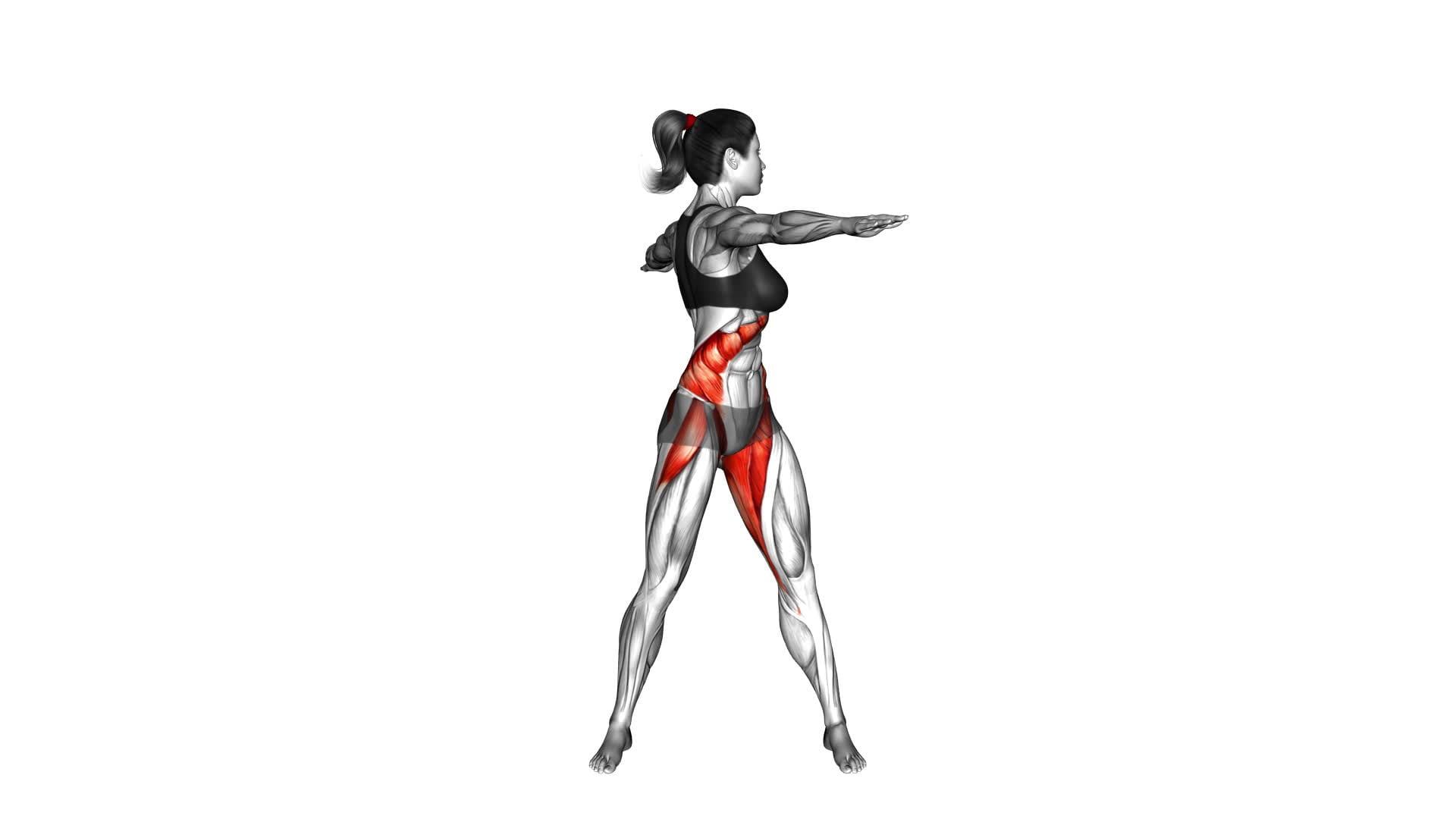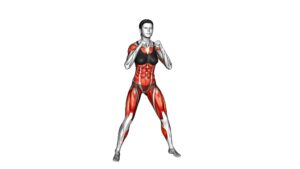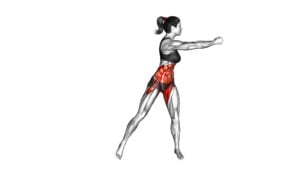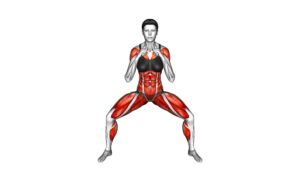Standing Torso Twist (female) – Video Exercise Guide & Tips

Get ready to tone your core with the Standing Torso Twist! This exercise targets your obliques and helps improve your overall stability.
Watch This Exercise Video
In this video exercise guide, we'll show you the proper form and technique, as well as modifications for different fitness levels. Avoid common mistakes and maximize your results with our helpful tips.
Get ready to feel the burn and strengthen your midsection like never before!
Key Takeaways
- Standing Torso Twist improves core strength and overall health.
- It targets abdominal muscles, obliques, and lower back.
- It enhances posture, balance, and stability.
- It increases flexibility and range of motion in the spine.
Benefits of the Standing Torso Twist
You should regularly incorporate the Standing Torso Twist into your exercise routine to reap its numerous benefits.
This exercise is highly effective in improving your core strength and overall health. The Standing Torso Twist primarily targets your abdominal muscles, obliques, and lower back, making it an excellent workout for toning and strengthening these areas.
By engaging and strengthening your core muscles, you can improve your posture, balance, and stability. Additionally, the Standing Torso Twist helps to increase your flexibility and range of motion in the spine, which can be beneficial for daily activities and sports performance.
This exercise also promotes better digestion and blood circulation, contributing to overall better health. To ensure you get the most out of the Standing Torso Twist, it's crucial to maintain proper form and technique. This will maximize the engagement of your core muscles and minimize the risk of injury.
Proper Form and Technique
To maintain proper form and technique when performing the Standing Torso Twist, focus on engaging your core muscles throughout the exercise. This is crucial for injury prevention and maximizing muscle activation.
Start by standing with your feet hip-width apart and your knees slightly bent. Keep your back straight and your shoulders relaxed. As you twist, imagine that you're rotating from your waist, not just your upper body. This will help you target the oblique muscles more effectively.
Remember to breathe deeply and exhale as you twist to engage your core muscles even further. Avoid using momentum to power the movement; instead, rely on the strength of your core. Keep your movements controlled and deliberate.
It's important to listen to your body and not push yourself beyond your limits. If you experience any discomfort or pain, stop the exercise immediately. By maintaining proper form and technique, you'll reduce the risk of injury and ensure that you're getting the most out of the Standing Torso Twist.
Modifications for Different Fitness Levels
There are various modifications available for individuals at different fitness levels to perform the Standing Torso Twist exercise. If you're a beginner, it's important to start with the basic modifications to build a strong foundation.
Begin by standing with your feet shoulder-width apart and placing your hands on your hips. Slowly twist your torso to the right, keeping your core engaged and your hips facing forward. Hold this position for a few seconds before returning to the starting position. Repeat on the left side.
As you become more comfortable with the exercise, you can increase the intensity by adding weights or using a resistance band. This will challenge your muscles and help you build strength and stability.
For those at an advanced fitness level, there are several variations you can try. One option is to perform the exercise on an unstable surface, such as a balance board or Bosu ball. This will require more core strength and stability to maintain your balance while twisting.
Another option is to perform the exercise with a medicine ball or kettlebell, adding resistance to the movement. This will engage your muscles even more and provide a greater challenge.
Remember to always listen to your body and choose modifications that suit your fitness level.
Common Mistakes to Avoid
Mistakes to avoid when performing the Standing Torso Twist exercise can hinder your progress and potentially lead to injury. To ensure proper technique and maximize the benefits of this exercise, it's important to be aware of common mistakes and avoid them.
One common mistake is twisting the torso too forcefully or rapidly. This can strain the muscles and increase the risk of injury. Instead, focus on controlled and gradual movements, allowing the muscles to engage and stretch without excessive strain.
Another mistake to avoid is using momentum to perform the twist. This can take away from the effectiveness of the exercise and put unnecessary stress on the joints. Instead, rely on the strength of your core muscles to initiate the movement.
Additionally, it's important to maintain proper posture throughout the exercise. Avoid rounding the shoulders or arching the back, as this can lead to discomfort and poor alignment. Remember to engage the core muscles and keep the spine neutral.
Tips for Maximizing Results
To maximize your results, focus on maintaining proper form and gradually increasing the intensity of the Standing Torso Twist exercise.
Proper form is crucial for maximizing the effectiveness of this exercise and preventing injury. Begin by standing with your feet shoulder-width apart and your knees slightly bent. Keep your back straight and engage your core muscles throughout the exercise.
As you twist your torso, make sure to rotate from your waist and not just your arms. This will target the muscles in your core and obliques more effectively. Start with a comfortable range of motion and gradually increase it as you become more flexible and comfortable with the exercise.
You can also incorporate variations of the Standing Torso Twist to challenge your muscles in different ways. For example, you can hold a weight or resistance band to increase the resistance and intensity. Another variation is to perform the exercise on an unstable surface, such as a Bosu ball or balance board, which will engage your core muscles even more.
Remember to listen to your body and modify the exercise as needed to ensure proper form and avoid any discomfort or pain.
Frequently Asked Questions
How Long Should I Hold the Standing Torso Twist Position?
To properly perform the standing torso twist exercise, it's important to know how long to hold the position. The duration of the hold depends on your fitness level and comfort.
Start with holding the twist for 10-15 seconds and gradually increase the time as you get stronger. Remember to engage your core and keep your back straight throughout.
Avoid common mistakes like twisting too forcefully or using momentum. Focus on controlled movements for maximum benefit.
Can the Standing Torso Twist Help in Reducing Waist Size?
Yes, the standing torso twist can help in reducing waist size. By engaging your core muscles and twisting your torso, this exercise targets the obliques and helps strengthen and tone your waist area.
The standing torso twist benefits include improving spinal mobility and posture. There are different variations of the standing torso twist that you can incorporate into your workout routine to add variety and challenge your muscles.
Is It Safe to Perform the Standing Torso Twist Exercise if I Have a History of Back Pain?
If you have a history of back pain, it's important to take precautions before performing the standing torso twist exercise. There are alternative exercises that can be more suitable for individuals with back pain.
It's advisable to consult with a professional or a physical therapist for modifications to the standing torso twist that can help alleviate any potential strain on your back. Safety should always be a top priority when exercising, especially if you have a history of back pain.
Can I Perform the Standing Torso Twist Exercise if I Am Pregnant?
During pregnancy, it's important to exercise caution when performing the standing torso twist exercise. This exercise involves twisting the torso, which can put strain on the abdominal muscles and the lower back.
It's recommended to modify this exercise by reducing the range of motion and avoiding deep twists. Alternatively, you can try gentle stretching exercises for the back and hips, such as cat-cow pose or pelvic tilts.
Always consult with your healthcare provider before starting any exercise routine during pregnancy.
How Frequently Should I Incorporate the Standing Torso Twist Exercise Into My Fitness Routine to See Noticeable Results?
To see noticeable results, incorporate the standing torso twist exercise into your fitness routine regularly. It's a great addition to a full body workout routine because it targets your core, improves flexibility, and strengthens your obliques.
Beginners can modify the exercise by starting with smaller twists and gradually increasing the range of motion. Remember to listen to your body and not push yourself too hard.
Consistency is key to seeing the benefits of this exercise.
Conclusion
In conclusion, the standing torso twist is a highly beneficial exercise for improving core strength and flexibility. By maintaining proper form and technique, individuals of all fitness levels can safely engage in this exercise.
It's important to avoid common mistakes and follow the tips provided to maximize results. Incorporating the standing torso twist into your fitness routine can help you achieve your fitness goals and enhance overall physical well-being.

Author
Years ago, the spark of my life’s passion ignited in my mind the moment I stepped into the local gym for the first time. The inaugural bead of perspiration, the initial endeavor, the very first surge of endorphins, and a sense of pride that washed over me post-workout marked the beginning of my deep-seated interest in strength sports, fitness, and sports nutrition. This very curiosity blossomed rapidly into a profound fascination, propelling me to earn a Master’s degree in Physical Education from the Academy of Physical Education in Krakow, followed by a Sports Manager diploma from the Jagiellonian University. My journey of growth led me to gain more specialized qualifications, such as being a certified personal trainer with a focus on sports dietetics, a lifeguard, and an instructor for wellness and corrective gymnastics. Theoretical knowledge paired seamlessly with practical experience, reinforcing my belief that the transformation of individuals under my guidance was also a reflection of my personal growth. This belief holds true even today. Each day, I strive to push the boundaries and explore new realms. These realms gently elevate me to greater heights. The unique combination of passion for my field and the continuous quest for growth fuels my drive to break new ground.







